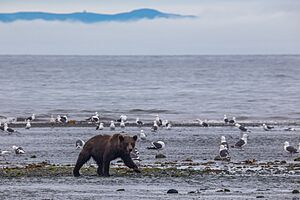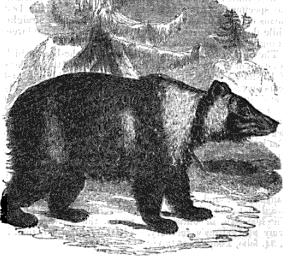East Siberian brown bear facts for kids
Quick facts for kids East Siberian brown bearRussian: Восто́чно-Сиби́рский бурый медведь |
|
|---|---|
| Conservation status | |
| Scientific classification |
|
| Kingdom: | Animalia |
| Phylum: | Chordata |
| Class: | Mammalia |
| Order: | Carnivora |
| Family: | Ursidae |
| Genus: | Ursus |
| Species: | |
| Subspecies: |
U. a. collaris
|
| Trinomial name | |
| Ursus arctos collaris F. G. Cuvier, 1824
|
|
| Synonyms | |
|
jeniseensis Ognev, 1924 |
|
The East Siberian brown bear (Ursus arctos collaris) is a type of brown bear that lives in a huge area of eastern Siberia. You can find them from the Yenisei river all the way north to the Arctic Circle. They also live in places like Trans-Baikaliya, the Stanovoy Range, and throughout Yakutia and the Altai Mountains. These bears are also found in northern Mongolia, northern Xinjiang (in China), and eastern Kazakhstan.
How Big Are They?
East Siberian brown bears are quite large! They are usually bigger than the Eurasian brown bears but a bit smaller than the very big Kamchatka brown bears. However, some really big East Siberian bears can grow to be as large as the Kamchatka bears. Their skulls (heads) are always larger than those of European brown bears.
Adult male bears have skulls that can be about 32.6–43.1 cm (12.8–17.0 in) long. Their fur is long, thick, and soft. It looks similar in color to the fur of European brown bears, but many East Siberian bears have darker fur.
Bear Behavior
Siberian bears tend to be much braver around humans than their European relatives. European bears are usually shyer because they have been hunted more. These Siberian bears often break into hunters' storage areas and huts if they smell food.
They also eat more meat than European brown bears. Interestingly, they don't seem to like honey very much! Like other brown bears, their diet includes many different foods. They eat fish, berries, and roots. They also hunt small animals like hares, and larger animals such as caribou and elk.





